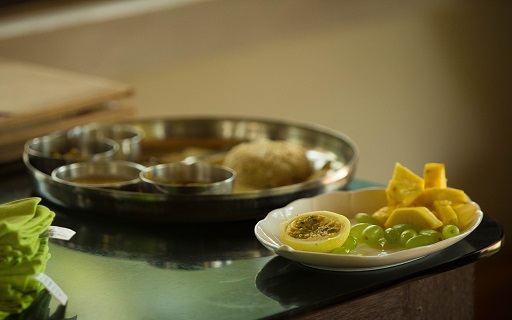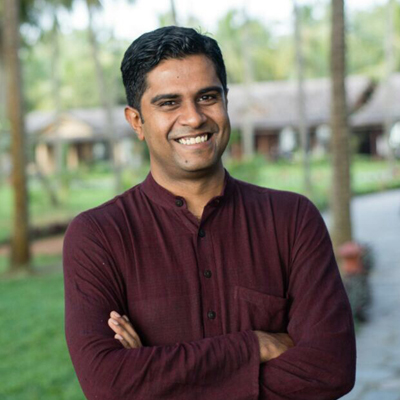What is the concept of food in Ayurveda?
The first time I went abroad, one of my friend invited me to an Ayurvedic restaurant for having lunch. The first time I went there I was quite fascinated to see that there is a concept called as Ayurvedic restaurant. And what I saw in the menu was, it was the Vegetarian Indian cuisine and called Ayurvedic cuisine. However, they had classified the food in to what will increase Vata, what will increase Pitta and what will increase Kapha. Of course, I’m not saying it is not right. However, it is important for us to understand these are not certain things that was explained in the scriptures of Ayurveda. It’s a completely new concept that is Westernized. It’s like you take any food, if we are able to understand what is the nutritional facts in that we can assess whether it is going to increase the Vata, Pitta or Kapha. Whereas in the scriptures of Ayurveda, more emphasis is mentioned on the taste of food because in ancient times we didn’t have the
nutritional facts such as the calories or to what extent is the sugar. But the more emphasis was done on the taste like sweet, salt, sour and according to the taste how it is going to affect their energy levels of our body. Is food served at Sitaram Beach Retreat based on Vata, Pitta and Kapha? And some people come to the place like here, they are slightly disappointed that we don’t have the concept of dosha food nor a buffet. See if you go to a real clinic and ask
for dosha food, it is like going to an authentic Italian restaurant and all you ask for is “oh, I want ketchup.” And that is not what an Italian restaurant owner will expect because they are preparing different kinds of spreads and sauce and all you ask for is industrialized ketchup. So this defeats the purpose of having so many varieties of dishes that is available in an Italian restaurant.
The same way, the concept here is during Panchakarma, our body is going through a lot of cleansing and at that time the gastronomy experience is not our priority. We are removing a lot of toxins that created the disease and depending on our lifestyle and the binge eating and overeating and the processed food that we are taking and the chemicals that are there. So here we follow a concept of farm to table as fresh as possible. And some of the rules that we advocate for people to follow after they leave here is if it is growing it is good to eat. The more it is packaged and the longer the shelf life it is going to stay longer in the body which is similar to a slow poison. So try to take food that are having very short shelf life and that is very live. Another thing is, one of the concepts that I understood is if you are washing your plates or the dishes that you cook your food in, if it is going to take more energy and detergent to wash that plate, that
means the food you’re taking is quite toxic for your body.
Because the body has to do the same effort after it takes all the nutrition to eliminateit from the system. So we have to reduce the energy the body has to invest in eliminating the toxins so the more easier the food is to digest, more energy we have. And at the same time during the course of Panchakarma, for example the ghee therapy, we will be giving you something called as the rice soup or the vegetable clear soup. During this time more semi solid liquid food we are able to absorb better. It’s like when you want to clean the road if the traffic is not there, the cleaning is much efficient but the traffic is there you clean for even three or four hours the cleaning need not be that efficient. Same way during Panchakarma especially the ghee therapy, we are giving food just for the survival because cleansing and purification and healing is our priority.
What is the food concept practised at Sitaram Beach Retreat?
Another question people ask is why we don’t offer a buffet style food. Like if they had gone to another place they saw a lot of Buffet varieties and why we are not offering the same. We need to understand the concept of Buffet and an intensive Panchakarma are contradictory to each of them. In Panchakarma, our sole aim is to enhance the immunity, to purify our body, to improve our metabolism. You are what you digest not what you eat. So in the process of when we are increasing and upgrading your metabolism, there needs to be discipline in the food that we are going to consume. And moreover we don’t want you to always get up and go and eat what is available. We want you to sit down and eat with peace. Let us do the joys of deciding what you want to eat and what is right for you to eat because according to your condition according to the therapies that you are going to do, your body will need certain foods that is mandatory. So we follow the nutrition that is mentioned in the Ayurvedic textbooks at the time of Panchakarma. For example, when you are going through a ghee therapy, the food has to be extremely easy to digest, for example like a rice soup or vegetable clear soup. Because during the ghee therapy, our gut is removing all the sticky toxins that are inside. If you eat extremely light food the cleansing is more efficient. So on these days we give you something really light to eat and on the day of purgation we give you a lot of fruits which are having citrus acid.
This enhances the elimination of Pitta from your body. The day before Vamana, we give you food that will enhance the Kapha in your body so that the Vamana procedure will give you the right benefits. So according to every treatment there is a food that will be allocated and on the other days after your cleansing we will give you food that will nourish your system and rejuvenate your system. So this is the concept that we follow, and sitting and eating with peace, that we are eating with mindfulness that makes a huge impact on our digestion and our metabolism.


